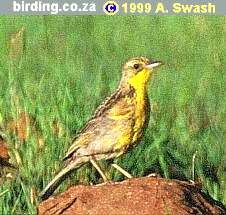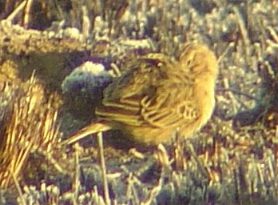
Mozambique Birding | Birding and Tour News | Features | Listing Clubs | Enquire
Birding South Africa | Birding Johannesburg/Pretoria | About us | Contact us | HOME
 |
Day Trips | Weekend Birding Events | Scheduled Tours | Customised Tours | Birding Courses Mozambique Birding | Birding and Tour News | Features | Listing Clubs | Enquire Birding South Africa | Birding Johannesburg/Pretoria | About us | Contact us | HOME Indicator Birding ccErectile Dysfunction | |
Birding News:Yellow Breasted Pipit (Geelborskoester) found in Gauteng - 7 July 2004On 7 July, Faansie Peacock and Etienne Marais confirmed the presence of at least 3 Yellow-breasted Pipits in the new section of Suikerbosrand. Martin Benadie had reported 2 birds on 30 June, co-incidentally very close to where Etienne Marais had seen a bird on 14 June, while birding with Ken Freeman of Australia. Yellow-breasted Pipit is listed in the Red Data Book as "Vulnerable" with an estimated population of 2500-6500 birds worldwide, all of which are found along the high grasslands adjacent to the eastern escarpement, between Mpumalanga and the Eastern Cape. The nearest to Gauteng that it is known to occur is around Dullstroom or Memel, in the eastern Free-state. The winter movements of this species are rather poorly known, although some birds are known to move to lower altitudes in winter, presumably to escape the harshest weather.
Yellow-breasted Pipit is listed in the Red Data Book as "Vulnerable" with an estimated population of 2500-6500 birds worldwide, all of which are found along the high grasslands adjacent to the eastern escarpement, between Mpumalanga and the Eastern Cape. The nearest to Gauteng that it is known to occur is around Dullstroom or Memel, in the eastern Free-state. The winter movements of this species are rather poorly known, although some birds are known to move to lower altitudes in winter, presumably to escape the harshest weather. The occurrence of at least 3 birds in the Suikerbosrand Nature Reserve for a period of over three weeks suggests that this is an area used by these birds for overwintering. As far as we are aware, these are the first records of this species for Gauteng, but given their non-descript plumage and the "ordinary highveld" habitat the birds are in, they may have been overlooked in the past. As the photo of one of the Suikerbosrand birds (below) indicates, they are not easy to identify! In order to be sure you are a looking at a Yellow-breasted Pipit, you will need to get a really good look at the birds, preferably with a scope.  These non-breeding birds are very brownish in overall look compared with breeding plumage birds - and need to be carefully looked at (Scopes essential). See our identification Notes Below: These non-breeding birds are very brownish in overall look compared with breeding plumage birds - and need to be carefully looked at (Scopes essential). See our identification Notes Below:
The birds were mostly silent, only one short (diagnostic) call being heard in about an hour of watching. No recordings were played. The "new" section of Suikerbosrand consists of 11 000 ha of land which is mostly reclaimed farmland. One section is currently accessibly (July 2004) via the Eendracht road, which is currently being used by some through traffic, and for which there is thus no access control (although this situation will change in future). The "Eendracht road" is on the left, 3 km from the N3 highway, along the road to Suikerbosrand. Once through the gate, proceed over a bridge (stream-bed) and some 100m further on there is a small rocky outcrop. The birds were at the end of the firebreak on the left hand side of the dirt road. The birds were seen amongst and just beyond these rocks, and at the edge of the longer unburnt grass at the end of the firebreak. Conditions were cold and frosty, and Yellow-breasted Pipit normally avoids burnt areas and short grass. They may have been foraging in more open areas, because of the frost and damp grass. IDENTIFICATION NOTES Our identification of the birds was based on the following features:
Visit the news Archive for birding news and trip reports. |
|